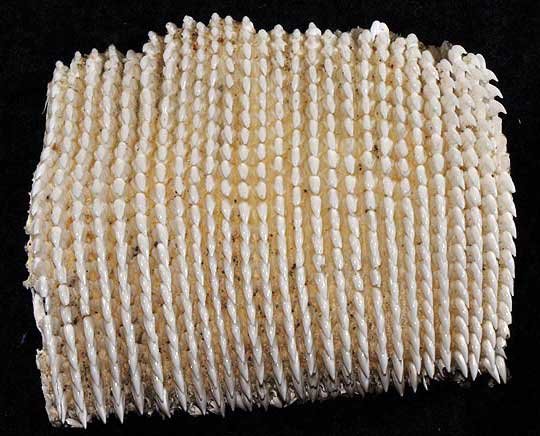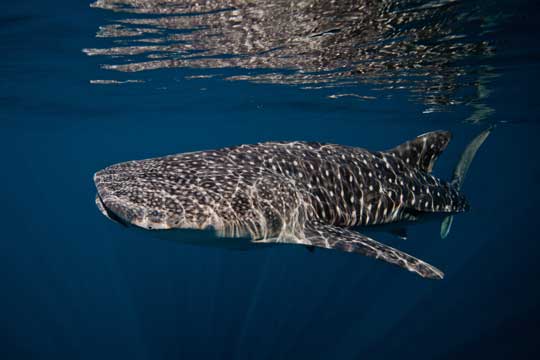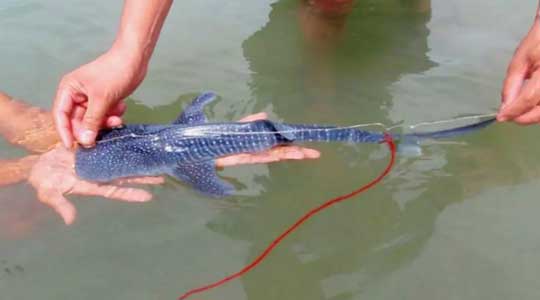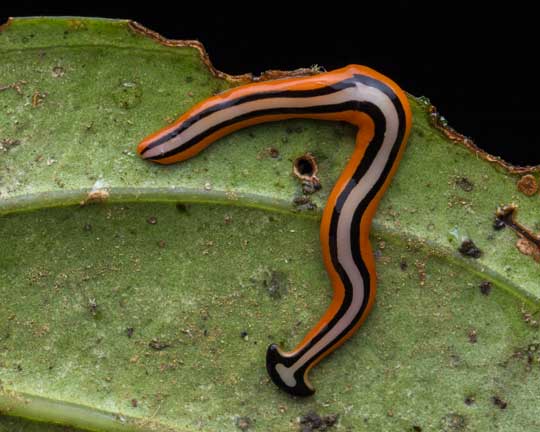|
Years ago Trish and I were in Boston, and we had a chance to go on a whale-watching boat tour for a few hours. We did indeed see a few whales, but for some reason, I was most excited when a massive whale shark swam right beneath us as we peered over the side of the boat. Whale sharks are the largest living fish. They are also the largest non-mammal vertebrate animal. How large are they? The biggest individual found was almost 19 meters (62 feet) long! If you're wondering about how much these fish weigh, well, very few of the really large ones have been weighed. However, one whale shark that was 39 feet (12 m) long weighed about 33,000 pounds (15,000 kg). It's time we take a closer look at this gentle giant. What the heck is a Whale Shark? First of all, whale sharks (Rhincodon typus) are not whales, they are sharks. As you probably know, whales are mammals (as are humans). Sharks, on the other hand, are fish. Just because whale sharks are sharks and are huge, that doesn't mean they are dangerous to people. Whale sharks are filter feeders--they filter plankton and small fish from the water. They do not attack and kill large prey. The whale shark is one of only three filter-feeding sharks—the other two are the basking shark and the megamouth shark. Amazing Facts about Whale Sharks Let's talk about this unusual filter-feeding habit. Whale sharks cruise along, mile after mile, swimming close to the surface, scooping up plankton in their huge mouths. Most sharks have a mouth that is located under their head, but a whale shark's mouth is situated right up front, to help scoop up all those yummy little plankton animals. Look at the size of that mouth! When measured, one whale shark that was 40 feet (12 m) long, had a mouth that was 5.1 feet (1.5 m) across. That's one big mouth! Although they are too small to see in the above photo, whale sharks have about 300 rows of teeny, tiny teeth. Below is a photo of a section of these teeth. Strangely, these teeth have nothing to do with feeding. In fact, they serve little (if any) purpose at all and are therefore considered to be vestigial teeth. The word vestigial refers to body structures that used to be larger and more functional but are in the process of going away over time due to evolution. An example of vestigial structures in humans are the muscles attached to our ears that used to allow our distant ancestors to move their ears, like many other animals can. So, if these thousands of teeth aren't used, how does a whale shark actually eat? As stated above, they cruise around, scooping up plankton. Sometimes they also actively open and close the mouth, sucking in water. With either method, a large quantity of water rushes into the mouth and is then expelled through the gills. So, what keeps all those yummy plankton animals from getting expelled along with the water? Well, situated on their gills, whale sharks have twenty comb-like structures called filter pads. As the water is expelled through the gills, the plankton and tiny fish get caught in these filter pads. Whenever the filter pads get full, the whale shark swallows all that stuff, making room for more. Remember that huge mouth? It's easily big enough for a human to swim into (or get sucked into). But even if that happened, the whale shark could not swallow a person because their throats are too narrow to swallow anything bigger than your fist. If you somehow accidentally got sucked into a whale shark's mouth, the shark would probably simply "cough" you back out. Whale sharks are often observed coughing out excess particles that they don't want to eat. Check out this video about whale sharks. Whale sharks are known to be very docile toward divers, often even allowing divers to grab hold and go for a ride. However, disturbing these magnificent fish in such a way is discouraged by biologists because it puts excess stress on the sharks. But observing them respectfully, even up close, is safe for both the diver and the fish. In fact, divers travel to various sites around the world just for the opportunity to see these creatures. The whale shark's huge size requires that it find areas with abundant food. These fish are notorious for incredibly long migrations (thousands of miles), in which they arrive at their destination just at the right time for an annual explosion of certain types of plankton. Keep in mind that whale sharks are slow swimmers, moving at only about three miles (4.8 km) per hour. So, such migrations take a looong time! Whale sharks are usually solitary, but sometimes they are seen swimming in groups of hundreds. Whale sharks grow really old. Although studying their age is difficult, scientists estimate that whale sharks live between 60 and 100 years, and some experts suggest that they can live up to 150 years. Because whale sharks are so difficult to study, they have never been observed giving birth. And mating has only been observed twice (from an airplane). However, we can deduce some information on their reproduction from other observations. Based on dissection of female whale sharks, we know these fish are ovoviviparous (have fun pronouncing that one). Ovoviviparous refers to a form of reproduction that is halfway between egg-laying (oviparous) and live birth (viviparous). Ovoviviparous animals have young that develop inside eggs, but the eggs stay inside the female's body until they hatch, and then the live young are born. Cool, huh? Here's where things get a little confusing. Female whale sharks can have a lot of fertilized eggs in their body at once. One female that was captured in 1996 contained about 300 shark pups. However, the females do not give birth to all these pups at once. Instead, they keep the sperm from one mating inside their body, and they give birth to only a few pups at a time. Apparently they can continue regularly producing pups like this for a long period of time. Below is the smallest whale shark pup ever found, which implies that this is about the size of newborn pups. This individual was found tied to a stake on a beach in the Philippines (notice the red string tied to its tail). No one knows why it was tied there, or where it came from, but it was measured and released safely into the wild. Because this is the smallest pup ever observed, we assume this is the size of newborn pups. We assume newborn pups are about 18 inches (46 cm) when they are born. I suppose because I have so many grandkids, I cannot read the phrase "baby shark" without an incredibly annoying song running through my mind endlessly. Baby shark, doo, doo, doo, doo, doo, doo... If you don't know what I'm talking about, you're lucky. So, the Whale Shark deserves a place in the S.A.H.O.F. (Sublime Animal Hall of Fame). FUN FACT: Depending on the source, the word sublime originated in the late 1400s or the 1500s. It came from the Latin sublimis, which means "uplifted, high, borne aloft, lofty, exalted, eminent, or distinguished." Today the word sublime has a variety of different meanings. In chemistry, it is a verb meaning "to convert (a solid substance) by heat into a vapor." It also has several uses as an adjective. For example, it can mean "elevated or lofty in thought or language" (example: Stan's novels are sublime literature). It can also mean "impressing the mind with a sense of grandeur" (example: The changing leaves in the fall provides sublime scenery). For our purposes today, though, I am relying on the definition "supreme or outstanding" (example: The whale shark is a sublime fish). So, sublime is another way to say awesome! Photo Credits:
- Whale shark #1, next to swimming diver - DepositPhotos - Whale shark #2, closeup of mouth - DepositPhotos - Section of whale shark teeth - D Ross Robertson, Public domain, via Wikimedia Commons - Whale shark #3, swimming near surface against dark background - DepositPhotos - Baby whale shark - Aquaworld
0 Comments
Due to the Halloween season, I'm going with a rather creepy-themed Awesome Animal today. I present to you the hammerhead worm—the coolest worm most people have never heard of. There's even a species with Halloween colors (see image below). Honestly, I didn't know anything about these until recently, and I immediately decided I needed to feature them as an Awesome Animal. What the heck is a Hammerhead Worm? Actually, these are not worms like earthworms. Earthworms are segmented worms. Hammerhead worms, on the other hand, are planarians, a type of flatworm. Sometimes they are called broadhead planarians. Another common name--landchovy. Most species of planarians live in freshwater or saltwater, but some types, like the hammerhead worms, live on land. Perhaps the most distinguishing characteristic is the broad, shovel-shaped head. Land planarians have what's called a creeping sole that allows them to move around. This creeping sole is on their ventral (belly) side, and it has a thick layer of cilia (moving, hairlike projections) that beat back and forth on a strip of mucus the worm lays down as it progresses forward. What, you didn't expect these things to produce copious amounts of slime? To top it all off, these worms are fierce predators, as well as cannibalistic. Oh, and they are invading North America, Europe, and many other parts of the world. And... if you cut them into pieces, you end up with more hammerhead worms. Oh... and some of them grow to 18 inches (half a meter) long. Amazing Facts about Hammerhead Worms Wait... what was that statement about cutting them up and ending up with more? Planarians are famously good at regeneration. You can literally slice one in half, either lengthwise or across its body, and in two to three weeks each half will grow a new planarian. If you cut one into five pieces, you might get five worms (this depends on several things, including how big the pieces are). In fact, this splitting is the main way most hammerhead worms reproduce. Yeah, they are capable of sexual reproduction—you know, with a male and female—BUT, hammerhead worms are hermaphroditic, which means each individual has both male and female sexual organs. Therefore, any individual can mate with any other individual. Strangely, though, they usually don't. Instead, they seem to prefer to make new hammerhead worms by splitting their body apart. This is known as fragmentation and is a handy form of asexual reproduction. How do they split themselves apart? Well, they stick the tail end part of their body to the ground (remember all that slimy mucus?), then they keep moving forward (remember that creeping sole?) until their body tears right in half. The broken piece they leave behind becomes a younger worm, growing longer and developing a broad hammer head in a few weeks. A hammerhead worm can break apart like this one or two times per month. Lifespan of a hammerhead worm: Potentially immortal. I know, that's weird, but get this—hammerhead worms have no respiratory system, no circulatory system, no skeleton, and their mouth is also their anus. Let's consider those one at a time. No respiratory system: There's no need. Oxygen enters and carbon dioxide leaves the worm's body by diffusing directly through the body wall. No circulatory system: There's no need, for the exact same reason as above. Mouth is also the anus: Now we're talking about the digestive system. It's a simple system. The mouth is located in the center of the ventral (belly) side. Food is taken in there and travels through a pharynx to a gastrovascular cavity, where it is digested, and because this cavity branches out to various parts of the body, that's how the nutrients get everywhere they need to be. Whatever is left over gets spit right back out the mouth. Nice. Let's talk about how these creatures eat. As I stated above, they are predators. Unfortunately, many of them kill and eat earthworms. In case you didn't know, when it comes to almost every aspect of an ecosystem, earthworms are the good guys. gardeners know you can't have healthy soil without earthworms. That's why invading hammerhead worms could be bad news. Hammerhead worms are vicious earthworm hunters. They glide around on the ground with their spade-like head held up, moving it back and forth like a radar. The broad head has special chemoreceptors that detect earthworm mucus. When they catch up to one, they subdue it with a coat of their own mucus (wow, there's a lot of mucus in this newsletter), then they tear it up into pieces. The hammerhead worm then extends its pharynx out of its mouth and secretes earthworm-dissolving enzymes all over the chopped-up prey. After the earthworm becomes soup, the predator sucks it all up, digests most of it, and spits the remains back out the mouth. These creatures are an earthworm's worst nightmare (although it seems unlikely earthworms have nightmares—they have very primitive brains). Hammerhead worms are also enthusiastically cannibalistic. They like eating each other. Hammerhead worms are native to Asia and Australasia. However, as I stated above, they are becoming invasive worldwide, probably due to being transported on horticultural plants. Possible solution: Maybe predators (or even people) could eat them. Nope. Many earthworms are edible, but these creatures are toxic. They contain a potent neurotoxin called tetrodotoxin, which is also found in some newts, pufferfish, and the blue-ringed octopus. Other than each other, they have few predators. If you pick them up, their surface mucus can cause skin irritation. And, of course, don't even try chopping them up. I know... I'm kind of making these creatures out to be overly creepy for this Halloween edition. But keep in mind that in their native habitats, hammerhead worms are important to the ecosystem and should not be killed. They are, after all, awesome animals. When it comes to invasive hammerhead worms, they could become a problem. If you see an invasive hammerhead worm, you can pick it up with gloves or tweezers and put it in alcohol, or salt, or a sealed container. It might also help to report it to local authorities, who might be tracking sightings in your area. So, the Hammerhead Worm deserves a place in the E.A.H.O.F. (Elegant Animal Hall of Fame). FUN FACT: The word elegant (meaning "tastefully ornate") originated in the late 1400s, and it came from the Old French élégant. Another definition, one that I think applies to the appearance of some of the hammerhead worms, is "graceful in form or movement." Yet another definition is "excellent; fine; superior," as in "This is an elegant wine." I suppose you could consider hammerhead worms to be nothing more than slimy, slug-like things, but you have to admit they have a rather delicate and graceful appearance, right? So, elegant is another way to say awesome! Photo Credits:
- Hammerhead worm from Borneo, orange, black, and white - DepositPhotos - Hammerhead worm, black and white - DepositPhotos - Hammerhead worm, black and orange #2 - Bernard DUPONT, Flickr, Creative Commons License (CC BY-SA 2.0) - Hammerhead worm, long, thin, black - "Hammerhead worm - Carita - West Java_IMG_2708" by fveronesi1 is licensed under CC BY-SA 2.0 - Hammerhead worm head, brown and white - DepositPhotos |
Stan's Cogitations
Everyone needs a creative outlet. That's why I write. Archives
July 2024
|











 RSS Feed
RSS Feed